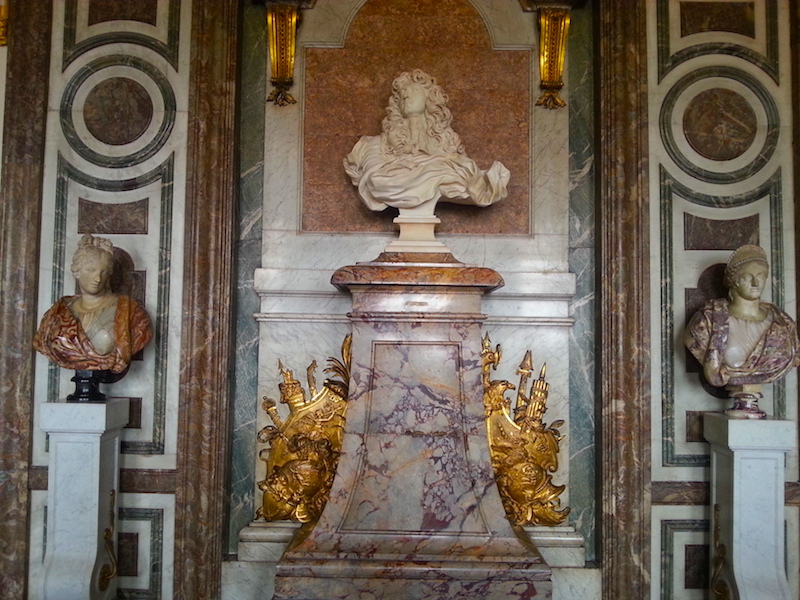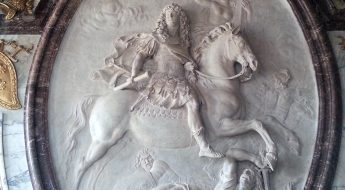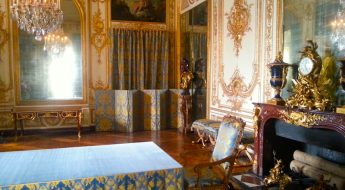
With Part 6, which covers the years 1710 to 1714, we conclude our series of posts on the War of the Spanish Succession.
In 1710, Louis XIV’s luck began to turn. He sent a new army into Spain to help Felipe V. In command was the Duc de Vendôme, this time without the Duc de Bourgogne to get in his way. Left to his own lights, the old duke defeated the Anglo-Austrian forces and drove them out of Spain by the end of the year. He returned to Versailles covered in glory and left Felipe V firmly on the Spanish throne once and for all.
Despite widespread hardship and misery in France, Louis XIV maintained Versailles and its court in the luxury to which it was accustomed. He even pushed ahead with the last major addition to Versailles in his reign, the chapel. It was completed in 1710. His stubbornness in this regard cost him the remaining respect and affection of his people for the rest of his life.

The interior of the chapel at the Château de Versailles, completed at great expense in the midst of the War of the Spanish Succession.
New Leadership in England and Austria
Meanwhile, momentous political changes were occurring in England. Long under the thumb of her tempestuous Mistress of the Robes, Sarah Churchill, Duchess of Marlborough, the exasperated Queen Anne finally dismissed her in 1710. This move was the beginning of the end for Marlborough himself. The Queen next dismissed her Whig cabinet, which was pro-war and pro-Marlborough, and appointed Lord Harley to head a Tory ministry, which was pro-peace. The new government began secretly negotiating with Louis XIV almost immediately, but the negotiations went slowly now that Louis was in a stronger position than just a year earlier.
To everyone’s surprise, the Emperor Joseph, aged only 32, died suddenly in April of 1711. This death changed everything. The Archduke Charles, the would-be Carlos III of Spain, was elected Emperor as Charles VI and inherited Austria, Hungary, Bohemia, and the other hereditary Habsburg lands. The English, the Dutch and their allies now faced the prospect of a reconstituted pan-global Habsburg empire stretching from Hungary to Spain to the New World. Their ardour to see Charles replace Felipe V suddenly cooled. At Harley’s urging, Queen Anne dismissed Marlborough from his command of the English forces in Flanders and appointed the Duke of Ormonde in his stead, with orders not to engage in battle. England and the United Provinces (i.e. the Netherlands) then openly invited France to a peace congress at Utrecht to start in early 1712. Naturally, this did not sit well with the Austrians.
Endgame
Prince Eugene, now in command of the Austrian army in Flanders, pressed ahead with the campaign of 1712. When England and France signed an armistice mid-year, Ormonde withdrew the English troops to Dunkirk (then still in Flanders, not France). The non-English units of his army, however, swelled Eugene’s ranks. It did little good, though, and Maréchal Villars managed to win the only French victories in Flanders of the whole war, taking Douai and some other towns. Though these victories were not debilitating to the Imperials, they strengthened Louis’ hand at the peace negotiations.
The final peace came in two stages. First, all the combatants except the Emperor signed the Peace of Utrecht on 11 April, 1713. The terms? Felipe V was confirmed in his possession of Spain and its New World territories, but gave up his Italian crowns to the Austrians, except for Sicily, which was given to the slippery Duke of Savoy, who had started out on the French side at the beginning of the war. England got Gibraltar and Newfoundland, and also the Asiento, the contract to carry slaves over the Atlantic to the Spanish colonies. The Dutch won their final independence and freedom from French aggression. The allied German states got nothing of value. France, utterly exhausted and nearly bankrupt, was happy to settle for some trade concessions and keep her borders intact.
Austria and France eventually signed the Peace of Rastatt on 6 March, 1714. By its terms, Louis surrendered his conquests on the east bank of the Rhine. France and Spain, much to Felipe V’s disgust and reluctance, also recognized Austrian control of Flanders, Milan, and Naples.
This YouTube clip is of the Gloria from George Frederick Handel’s Te Deum in honour of the Peace of Utrecht:
The Aftermath
The War of the Spanish Succession was perhaps the most consequential of the 18th century. Here’s why:
- The acquisition of Gibraltar and the winning of the Asiento assured British naval dominance of the Mediterranean for the next 200 years and control of the Atlantic slave trade until its abolition in 1808.
- France’s subsequent Bourbon kings, Louis XV and Louis XVI, were never able to put the French state’s finances to rights again, which was a direct cause of the Revolution of 1789.
- The Dutch were finished as a great power in Europe. Their finances, too, never recovered from the cost of fighting this war.
- No one was happy with the Italian situation at war’s end. The Duke of Savoy exchanged Sicily for Sardinia in 1718, and there were two further wars, the War of the Quadruple Alliance (1716-1719) and the War of the Polish Succession (1733-1736), in which Spain, France, Savoy, and Austria attempted to re-organize the map of Italy.
I hope you have followed this 6-part series on the War of Spanish Succession with interest. Please post any questions or comments below, on the Versailles Century Facebook page, or in the Versailles Century gallery on Instagram.

















Leave a Comment